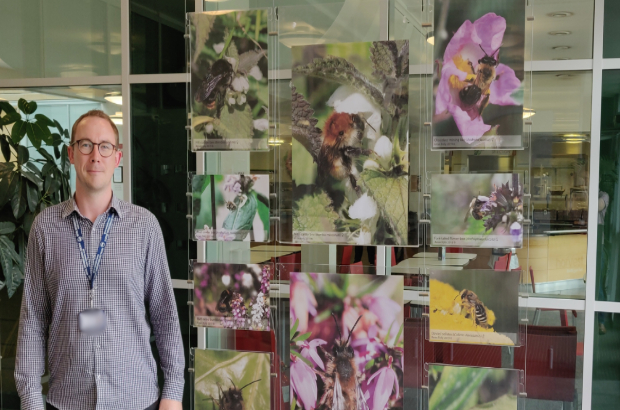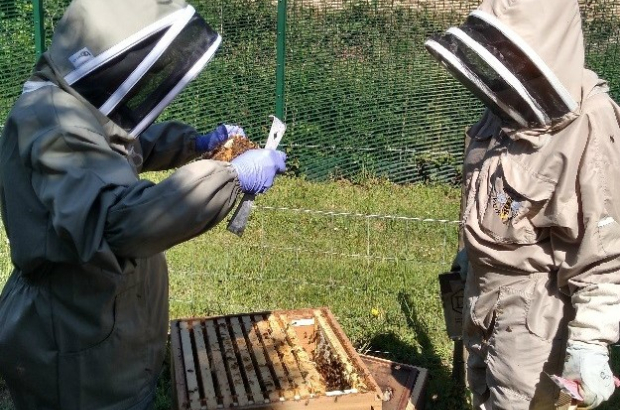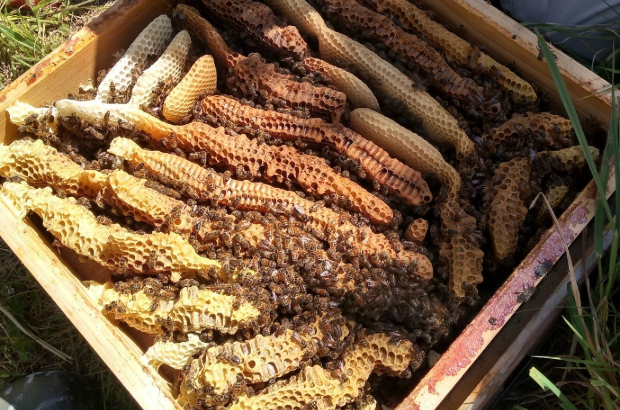Bees are really important pollinators and are therefore critical for our food security. To celebrate Bees’ Needs Week (8-14 July) Arran Folly and Mark Thomas talk more about these amazing creatures.
Threats to bees

Arran Folly, who recently completed a PhD researching bee diseases, discusses some of the threats bees face and what we can do to help.
On lazy summer days, when the sun is high and a cacophony of colourful flowers sway gently in the breeze, there is nothing better than relaxing outdoors, possibly with a nice cold beverage. However, this well-earned peace can often be interrupted by a hum, a buzz, and the sight of a rather cumbersome insect going about its gruelling daily task, relentlessly dancing between flowers, foraging to feed many hungry mouths. For some this is a nuisance, to be shooed away, or even run from! For me it is quite the opposite, bees are fantastic, captivating creatures that provide essential pollination services, and for this Bees’ Needs Week I wanted to highlight some of the amazing diversity we see in bees, but also the threats that they currently face.
Bees evolved around 120 million years ago, from a rather enterprising wasp that decided to pass on the insect heavy diet and go full vegan! Since then, there are approximately 16,000 species of bees recognised globally, and over 250 species in the UK. Some are large enough to have been described as flying mice, some are small enough to land on a pin head, some are bright metallic green, others are classically striped, some are social with a queen residing over her empire, and some are solitary and live as individual family units. However the one thing they all have in common is they require nectar (which is sugar rich and provides carbohydrate for energy) and pollen (which is protein rich and helps larvae grow). Indirectly by moving from flower to flower to gather their food, bees deposit pollen which means that flowers can be pollinated! However, a number of these wonderful insects are undergoing range and population declines and it is becoming increasingly important to understand why this is happening and how we can help.

Bees are impacted by a number of stressors, including a decrease in wildflower meadows, an increase in pesticide use and an increase in disease prevalence. It is generally accepted that these factors are interacting and leading to a decline in some bee species. Pesticides are designed to kill or disable insect pests so it is easy to see how these chemicals may have lethal or sub-lethal impacts on bees, similarly it is easy to understand that planting more flower rich areas will help provide food and habitat for bees and other insects. However, my background is in bee disease ecology and as we at the APHA are concerned about animal diseases, it is this stressor that I wanted to outline in a little more detail.
Like humans, bees can catch diseases. These can be parasitic or bacterial, where tiny organisms invade the host and cause symptoms of disease or they may be viral, where disease originates intracellularly following infection. Like zoonotic diseases in humans some of the diseases that impact bees are not species specific. Unfortunately diseases such as deformed wing virus, which was originally considered to be specific to honeybees, has now been found in bumblebees and other species. This means that bees foraging on flowers can come into contact with other bee species that may transmit non-specific diseases. With decreasing wildflower abundance, bee density and visits to individual flowers both increase as there are fewer resources. Consequently there may be more disease transmission interactions, and it is easy to see how these debilitating diseases are able to increase their environmental prevalence.

But there are ways to help, first and foremost if you want to help bees you should plant bee friendly flowers. There is really good evidence that back gardens, window boxes and herb gardens no matter how big or small create wildflower corridors which help link up bee populations and may help dilute diseases. Other exciting work has shown that natural chemicals in some nectars can help reduce the impact of bee diseases, so flowers might actually be like medicine for bees! Secondly, provide nesting habitats, dead or rotten wood is great for leaf-cutter bees and sand rich soils are really good for mining and flower-bees. But, most of all, get outside and appreciate the bees, they help produce the food you put on your plate, and to me at least, they are gorgeous components of our natural world.
Update on the Weybridge Bees
Mark Thomas, tells us more about the Weybridge bees, which have been on site for almost three years now.
Perhaps it is my age, but the season hardly seems to have started, but in reality it is already well advanced. This year started with a degree of sadness as we had lost one of the colonies over winter. This particular colony had been severely weakened towards the end of last summer having been the victim of sustained wasp attacks. I understand that it is nature, but it was heart-breaking to open the hive and see the wasps were on all the frames and the bees fighting for their very survival. The remaining colony was transferred into a smaller hive with a very small entrance which would be easier to guard against wasps. This was successful, however the colony was now very small and despite help, did not as we feared make it through the winter. Indeed we were not alone and several beekeepers in the areas suffered colony losses.

In May, following an invitation we made at last year’s Annual Science Day at Weybridge, we were visited by colleagues from the National Bee Unit. The visit was enjoyable and mutually beneficial as our hives could be used as part of the training for new seasonal bee inspectors, as well as the new technology they were using. We benefited from having our hives inspected for disease and unofficially some helpful practical input from more experienced beekeepers, dealing with some of the problems we had encountered and caused ourselves.
The National Bee Unit supports Defra, Welsh Government and Scotland's Bee Health Programmes and the Healthy Bees Plan to protect and sustain our valuable national bee stocks. The BeeBase website provides helpful information for beekeepers on keeping colonies healthy and productive.

As far as the apiary stands at the moment, the bees are working hard and there are several local food sources including the brambles which remain in flower along the perimeter banking. We recently acquired two further colonies bringing the total number of hives in our apiary to seven. Our weekly inspections continue and the bees appear to be in good condition and are rapidly building stores to ensure they have everything they need after October when they will become more dormant.
All being well we will look to harvesting honey in August, but are always at the mercy of the conditions and factors beyond our control. Recent alerts for European Foulbrood (EFB) and sightings of the Asian hornet, both relatively close to the Weybridge site heighten the need for awareness, observation and good biosecurity.
Why not get involved
2019 is Defra’s Year of Green Action so why not get involved by following @DefraNature and @DefraGovUK on twitter and by using #BeesNeeds and #YearOfGreenAction. You can also help pollinators directly to find food and shelter by following these 5 simple steps (source: Bumblebee Conservation Trust):
- Grow more flowers, shrubs and trees
- Let your garden grow wild
- Cut your grass less often
- Don’t disturb insect nest and hibernation spots
- Think carefully about whether to use pesticides
More information can be found on the Year of Green Action website.

1 comment
Comment by Derek Tanner posted on
Excellent articles